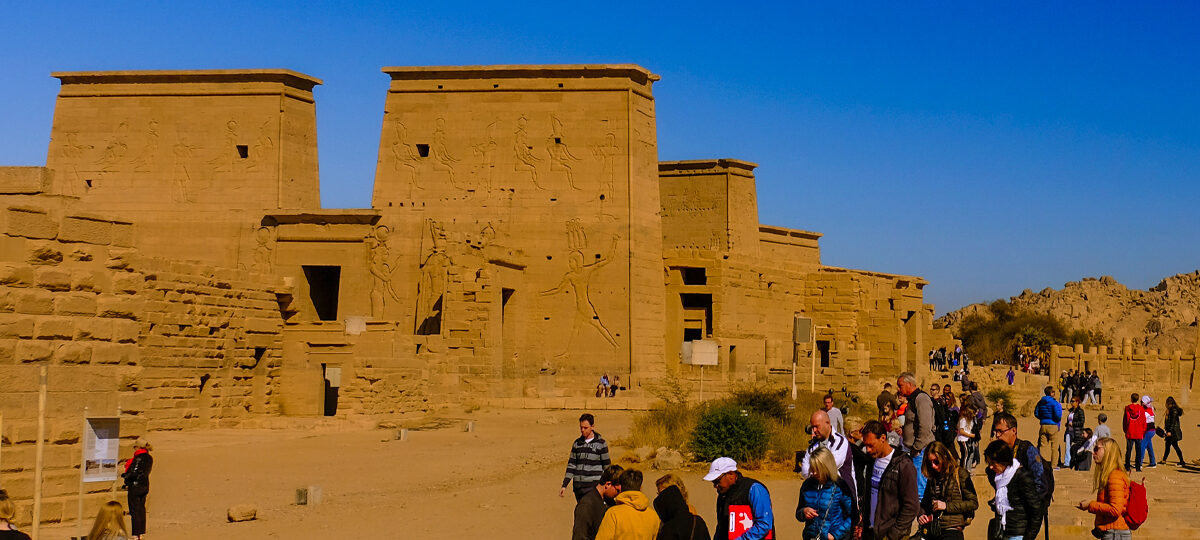Philae Temple
Philae Island is a significant island in Aswan. According to legends, it was considered one of the burial places of the god Osiris, which is why it was a sacred island by the Egyptians and Nubians. Philae Island was a temple complex 8 km south of Aswan, and these temples were built during the Ptolemaic and Roman periods. The Temple of Isis (Philae Temple) at Philae is one of the prominent sanctuaries of the goddess Isis in Egypt and is the main Temple on the Island.
The best way to learn about the ancient Egyptian culture that thrived along the banks of the Nile is to take the Nile Cruises. So Don’t miss booking our Best Nile River Cruises.
The History of the Philae Temple

The Temples of the Philae Complex were built over three centuries. The construction of the Philae temple began under the reign of one of the last pharaohs of the Pharaonic era, Nectanebo I (dynasty XXX). Later, most buildings were added under Greek rule, including the great Temple of Isis. In the 2nd century, it was considered a pilgrimage destination.
In the 6th century, the temples were closed by the Byzantine Emperor Justinian I. Christians used some of the buildings until the arrival of the Arabs in the 7th century. In the 19th century, Philae Island was submerged after constructing the Aswan Lower Dam. In the seventies, the Island sank during the construction of the High Dam, so it was moved to a higher island.
The mythology of the Temple; According to legend, when Osiris married the goddess, Isis, his brother Set murdered Osiris and cut him to pieces. So Set distributed the parts of Osiris’s body throughout Egypt. The wife, Isis, picked up her husband’s body and brought her back to life. Isis then took the Isle of Philae as a refuge from Set.
The Transfer of the Philae Temple

Philae Temple is not on its original site. The Temple was on Philae Island, but due to the annual flooding, the Island was underwater, and after the construction of the Lower Dam, it remained that way. The Temple would be submerged forever during the High Dam’s structure, and saving it would not be easy. In 1960, UNESCO cut the stones of the Temple (almost 40 thousand stones) and moved it to another island ”Aguilkia Island”. The Temple was painstakingly moved stone by stone.
The Construction of the Philae Temple
Philae Temple contains many buildings, the oldest among them dating back to the time of Nectanebo I. In the complex, there are; The kiosk of Nectanebo I (first pharaoh of the XXX dynasty), the booth of Trajan (Roman emperor), the small Temple of Hathor (cow goddess), the Temple of Harendotes (a form of the god Horus), the kiosk of Psammetichus II ( of the 26th dynasty), the bastion of Hadrian (Roman emperor), the Temple of Imhotep (architect of the 3rd dynasty), the Chapel of the Mandulis (god of Nubia) and the Temple of Dedun (god of Nubia).
The most important in Philae

The Temple of Isis
It is the essential building in Philae. The entrance is a processional path that leads to the first tower. On one side of the road is an arcade with 32 columns, and the other is damaged; at its end, the first tower leads to a courtyard where there is the Mammisi of Horus (birthplace of Horus). The second tower also leads to a hypostyle hall with ten columns and the sanctuary. The entire Temple is decorated with bas-reliefs of Horus, Isis, and Osiris scenes.
The Temple of Hathor
It was built in the time of Ptolemy VI. It consists of a hall with columns and an outside patio. The room was decorated in the time of Augustus with festive representations in honor of Isis and Hathor. In the reliefs, the emperor Augustus appears, making offerings to Isis and Nephthys.
Trajan’s Kiosk
It is a building with fourteen columns from Roman times with flower capitals. It is currently a structure without a roof, 20 m long, 15 m wide, and 15 m high. Its function is unknown, but it is believed from the two openings on the east and west that it was a stopover for Isis’ holy ship or was used as a shelter for Isis’s brig on the eastern shores. It is richly decorated with reliefs of Trajan, who completed its decorations.
The Nectanebo Kiosk
It is located on the southwestern tip of the Island. It is a room with fourteen columns crowned with capitals representing the cow goddess Hathor. It is the oldest building on the Island and was dedicated to the goddess Hathor.
The Sound and Light Show at Philae Temple
The sound and light show at Philae is a magic of lighting under the night sky. One walks around listening to an account of the legends of Isis, Osiris, Set, Hathor, Horus, the Nile, and the story of Philae. Listening to the stories while enjoying the changing lights is so beautiful.
Check Our Top Nile Cruise Trips:-

